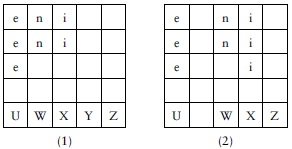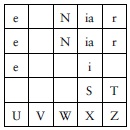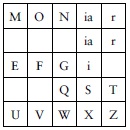Have His Carcase (53 page)
Authors: Dorothy L. Sayers

Wimsey clawed a little at his hair and sat muttering.
‘It looks as though we’d sucked our five letter rather dry,’ said Harriet.
‘How about trying the rest of the message? I’ve got it al ready sorted out into


pairs. Hulo! Here’s our old friend EXMG appearing again in the body of it.’
‘Is there?’ Wimsey sat up. ‘Then, if we’re right, that wil be another date in
June. I can’t believe it’s part of two words, one of which ends in J, or I, or JU
or IU or IUN or JUN. If the letter was making an appointment for June 18th,
why shouldn’t the two letters before it be the letters for 18, that is AH? We’l
try it, anyway; what are they?’
‘O.B.’
‘OB=AH. That’s a fat lot of use. Wel, we’l stick ’em down.
O and A in the same line, O and H in the same line, and A and B we knew
about before. That looks as though we might be on the right track, but it
doesn’t help us much, because none of the letters we’ve already placed comes
into it.’
‘Just a moment,’ put in Harriet. ‘I’ve got a brainwave. That town in the
heading – it’s supposed to be something in Central Europe. It’s got six letters,
and the last two are the first two reversed. How about Warsaw?’
‘By jove! that’s bright! We can but try it. Let’s see – that gives us this He
wrote down the new pairs of diagonals.
‘W and X come in the same line,’ he observed, ‘and it’s terribly tempting to
imagine that W comes in the last line, next door to X. Otherwise, of course, it
must be in the keyword. Just for fun, let’s enter it in the last line in both our
diagrams. Now, this becomes interesting. W and N are also in the same line.
We can’t place N in the fourth line down, because it’s got to be in line with E.
Nor can we put it in the third line down, because there are only six letters that

come between N and U, and we should have eight spaces left to put them in.
Therefore, if W is rightly placed, N has got to go in the top two lines, which
means that it definitely does belong to the key-word.’
Harriet filed the letters in tentatively.
‘That makes Diagram 1 took wrong,’ she said. ‘Why? What have we done?
Oh, I know. E and N can’t come together, so if that’s the right diagram, E must
come in the third line. I
say!
That would mean a key-word of eleven letters!’
‘Not necessarily. E may be in its proper alphabetical place. But if Diagram 1
is right, then the beginning of Line 3 is the only place for it. Let’s get on. S and
T come in one line, and so do R and T, but RST don’t folow one another, or
RS would become ST, which it doesn’t. I should like ST to go in the two
places next before U, but we can’t be sure that that is the right place for them.
Wel, dash it! stick ’em down – if we’re wrong we must do it again, that’s al.
There! Now, in that case, R must be in the key-word and therefore in one of
the top two spaces on the right of the diagram. That means that RS wil be
something-T.’
‘But we know RS! If AT = RS, then RS = AT.’
‘Good lord! so it does! That’s fine! That practicaly proves that our S and T
are correct. And now we know that AR must come next to one another in the
key-word.’
Harriet pored over the diagrams again.
‘Can’t we do something now with NX = AW? Yes – look! If we put A into
either of the squares in Diagram 1, so as to make NX = AW, then A won’t
come next to R! So either we’re al wrong, or we can wash our Diagram 1

altogether.’
‘Hurray! Briliant woman! I always hated Diagram 1, so we’l stash it. That
leaves us with a very hopeful-looking Diagram 2.’
‘I’m glad you think it’s hopeful! How about this business of M and N coming
in the same line? Can we do anything with that now?’
‘Why not? Let’s try. Put M immediately below the N spaces. That leaves
five spaces between it and S and only three letters to fil them, because we
know that N and R are in the key-word. So that M must come in one of the
four spaces in the top left-hand corner. Now we do know that NE = MG.
Obviously G can’t come immediately between E and N anywhere, because that
would give us a key-word with MNG in it, which sounds almost incredible. But
that stil leaves us with several possible arrangements. Is there anything else we
can do?’
‘We can fil in Q in the space before S. It isn’t likely to be in the key-word
without its U, and we know roughly what has become of R.’
‘Yes. Al right. There it is. Do any of these pairs of letters make sense in the
letter itself, by the way?’
‘No. I’ve been trying to fit them in, but they’re remarkably unhelpful. There’s
a group AT GM which works out as RS EN, but that might be anything. And
quite near the beginning there’s TS folowed by QJ. TS = SQ, and you’d
expect the next group to be U-something, but it isn’t. QJ must be S-something.’
‘So it is; that shows we’re on the right track. Q is an arbitrary letter stuck in
to separate the two S’s. It’s curious how little one can get out of the actual text
at this stage. Shows what an ingenious beast of a code it is, doesn’t it? Wait a

jiff – the group before that is MG = NE – that gives us NESS. Perfectly
possible and even probable, but it might be anything. Here it comes again!
Whatever it is, it appears to be important – its the same word, BFFY folowed
by NESS, but BFFY is simply baffling, I can see nothing for it but to go on
struggling with the top left-hand corner. Let’s write out al the possible positions
for NE = MG.’
‘I can see one thing,’ said Harriet, ‘and that is that we have got to have a
vowel of some kind between M and N, and that vowel can’t be A, E, I, or U,
because we’ve placed those elsewhere. Therefore it’s got to be either O or Y.’
‘O for preference. The number of words with MYN in them must be limited.
But Y has got to be in the key-word somewhere. The end would be the likeliest
place for it. perhaps it ends in MONY. That gives us MONY in Diagram (1),
and a word of nine letters. That’s quite plausible. And it’s got to begin with E –
G. That’s less pleasant. EBG, ECG – let’s run through the alphabet. EHG – I
think not. EIG – pronounceable, but we got I elsewhere. ELG – where’s the
dictionary? Nothing there. ENG is impossible, we know where N is – same
with ERG. My child, you can wash out al words ending in MONY – they
won’t work on Diagram (1) or on Diagram (3), and as for Diagram (2), I refuse
to believe in a fourteen-letter word until I’m absolutely forced to.’
‘In that case, you can wash out Diagram (2) altogether.’
‘Right-ho! I don’t mind, though a thirteen-letter word ending in MON is not
absolutely inconceivable. In that case, either our word begins with Mon, or it
doesn’t.’
‘But it does! We couldn’t find any words beginning E – G.’
‘Nor we could.
Now
then! We’ve got our E and our G fixed as wel as our
MON. Now we shan’t be long! Fil them in! Oh! and look here! I’m sure the F

must go between the E and the G – it’s so obviously the place for it.’
Harriet filed the diagram in with a quivering pencil.
‘That
does
look better,’ she admitted. ‘Now, let’s see if it helps to get any
sense out of the letter. Bother! What a lot of groups that we stil haven’t got!
Stil no sense for BFFY. Oh! wait! Here’s something! MZ TS XS RS. Now,
MZ is something-U, and quite possibly RU; it’s a 50–50 chance, anyway. TS is
SQ and XS is S-something, which means that the Q is just a fil-in letter. Now
suppose XS = SI – there’s no reason why it shouldn’t. Then RS might quite
likely be AT – there’s nothing against it. And suppose – suppose al these
